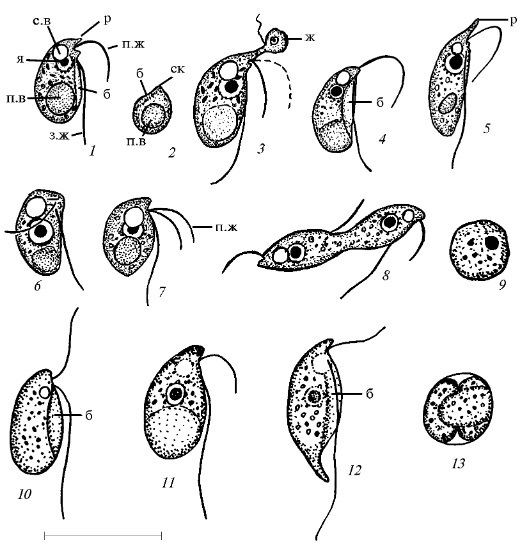Rank Genus | ||
 | ||
Family ColpodellidaeSimpson & Patterson, 1996 People also search for Voromonas, Duboscquella, Acrocoelus | ||
Colpodella is a genus of alveolates comprising 5 species, and two further possible species: They share all the synapomorphies of apicomplexans, but are free-living, rather than parasitic. Many members of this genus were previously assigned to a different genus - Spiromonas.
Contents
The type species is Colpodella pugnax Cienkowski 1865
Description
These are small (< 20 μm in diameter) flagellated protists. The life cycle of consists of two main stages: flagellated trophozoites and cysts, which are the reproductive stage in the life cycle.
Morphologically the trophozoites of Colpodella are similar to Perkinsus zoospores, although the two taxa are not specifically related. The motile stages of both genera have a pair of anterior orthogonal flagella, vesicular mitochondrial cristae, inner alveolar membranes and micropores. Both Colpodella and Perkinsus species have open sided truncated conoids (sometimes called pseudoconoids), rhoptries that occupy the length of the cell and smaller micronemes. Both the rhoptries and micronemes arise at the anterior portion of the cell. A three-layered pellicle lies beneath the plasma membrane and is otherwise composed of the alveolar membranes and widely separated microtubules that arise subapically. Some species have extrusive organelles (trichocysts).
Unlike Perkinsus, Colpodella are free-living and are voracious predators of other free-living protists. Most species apparently penetrate through the cell membrane and consume the prey's cytoplasm - this mode of feeding is known as myzocytosis. While feeding the predator attaches its anterior portion - the rostrum - to the prey. The rostrum contains the pseudoconoid, which transforms into a ring of microtubules encircling the attachment zone. The cytoplasm of the prey is then drawn into a large posterior food vacuole.
Following feeding cells lose their flagella, become spherical, encyst and divide (i.e. reproduce). The cysts are simple spheres. The food vacuole appears as a large central vacuole in the cyst; as division progresses the remnant vacuole material is reduced to a residual body. Typically Colpodella divides into four daughter cells (sometimes just two). This is in contrast to true Apicomplexa and Perkinsus, which typically produce many more daughter cells during reproduction - Perkinsus species can produce up to 32 cells, for example, while Toxoplasma produces 128. The daughter cells grow flagella, the cyst wall ruptures, and the cells swim away, leaving the residual body behind. A possible sexual process has been observed in at least two species.
Taxonomy
This family appears to be a sister clade to the Apicomplexa. Their life style may be representative of the free living ancestors of the Apicomplexa. One significant difference is that this genus, like the Perkinsea, have an open sided conoid (pseudoconoid) while the Apicomplexa which possess a conoid (the Conoidasida) have a closed conoid.
Another genus in this family is Acrocoelus.
Clinical
These organisms are not normally considered to be human pathogens. However, a report of an infection of the erythrocytes in a Chinese woman with a deficiency of natural killer cells has been reported.
